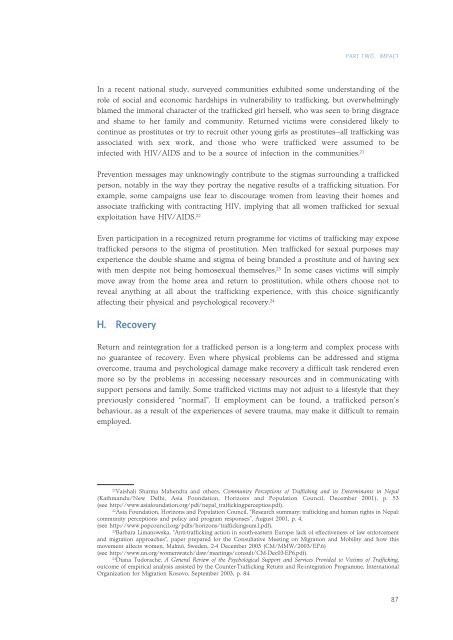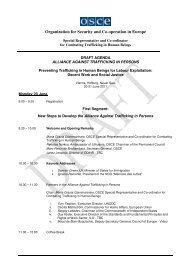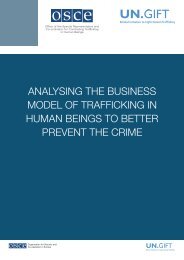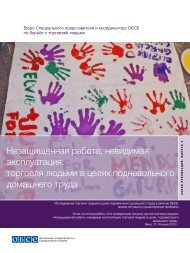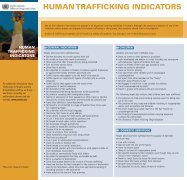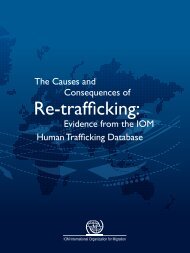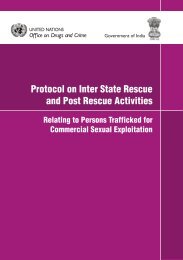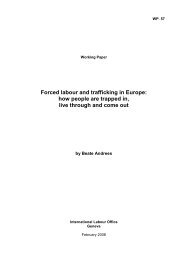An Introduction to Human Trafficking - United Nations Office on ...
An Introduction to Human Trafficking - United Nations Office on ...
An Introduction to Human Trafficking - United Nations Office on ...
You also want an ePaper? Increase the reach of your titles
YUMPU automatically turns print PDFs into web optimized ePapers that Google loves.
PART TWO.—IMPACT<br />
In a recent nati<strong>on</strong>al study, surveyed communities exhibited some understanding of the<br />
role of social and ec<strong>on</strong>omic hardships in vulnerability <str<strong>on</strong>g>to</str<strong>on</strong>g> trafficking, but overwhelmingly<br />
blamed the immoral character of the trafficked girl herself, who was seen <str<strong>on</strong>g>to</str<strong>on</strong>g> bring disgrace<br />
and shame <str<strong>on</strong>g>to</str<strong>on</strong>g> her family and community. Returned victims were c<strong>on</strong>sidered likely <str<strong>on</strong>g>to</str<strong>on</strong>g><br />
c<strong>on</strong>tinue as prostitutes or try <str<strong>on</strong>g>to</str<strong>on</strong>g> recruit other young girls as prostitutes—all trafficking was<br />
associated with sex work, and those who were trafficked were assumed <str<strong>on</strong>g>to</str<strong>on</strong>g> be<br />
infected with HIV/AIDS and <str<strong>on</strong>g>to</str<strong>on</strong>g> be a source of infecti<strong>on</strong> in the communities. 21<br />
Preventi<strong>on</strong> messages may unknowingly c<strong>on</strong>tribute <str<strong>on</strong>g>to</str<strong>on</strong>g> the stigmas surrounding a trafficked<br />
pers<strong>on</strong>, notably in the way they portray the negative results of a trafficking situati<strong>on</strong>. For<br />
example, some campaigns use fear <str<strong>on</strong>g>to</str<strong>on</strong>g> discourage women from leaving their homes and<br />
associate trafficking with c<strong>on</strong>tracting HIV, implying that all women trafficked for sexual<br />
exploitati<strong>on</strong> have HIV/AIDS. 22<br />
Even participati<strong>on</strong> in a recognized return programme for victims of trafficking may expose<br />
trafficked pers<strong>on</strong>s <str<strong>on</strong>g>to</str<strong>on</strong>g> the stigma of prostituti<strong>on</strong>. Men trafficked for sexual purposes may<br />
experience the double shame and stigma of being branded a prostitute and of having sex<br />
with men despite not being homosexual themselves. 23 In some cases victims will simply<br />
move away from the home area and return <str<strong>on</strong>g>to</str<strong>on</strong>g> prostituti<strong>on</strong>, while others choose not <str<strong>on</strong>g>to</str<strong>on</strong>g><br />
reveal anything at all about the trafficking experience, with this choice significantly<br />
affecting their physical and psychological recovery. 24<br />
H.—Recovery<br />
Return and reintegrati<strong>on</strong> for a trafficked pers<strong>on</strong> is a l<strong>on</strong>g-term and complex process with<br />
no guarantee of recovery. Even where physical problems can be addressed and stigma<br />
overcome, trauma and psychological damage make recovery a difficult task rendered even<br />
more so by the problems in accessing necessary resources and in communicating with<br />
support pers<strong>on</strong>s and family. Some trafficked victims may not adjust <str<strong>on</strong>g>to</str<strong>on</strong>g> a lifestyle that they<br />
previously c<strong>on</strong>sidered “normal”. If employment can be found, a trafficked pers<strong>on</strong>’s<br />
behaviour, as a result of the experiences of severe trauma, may make it difficult <str<strong>on</strong>g>to</str<strong>on</strong>g> remain<br />
employed.<br />
21<br />
Vaishali Sharma Mahendra and others, Community Percepti<strong>on</strong>s of <str<strong>on</strong>g>Trafficking</str<strong>on</strong>g> and its Determinants in Nepal<br />
(Kathmandu/New Delhi, Asia Foundati<strong>on</strong>, Horiz<strong>on</strong>s and Populati<strong>on</strong> Council, December 2001), p. 53<br />
(see http://www.asiafoundati<strong>on</strong>.org/pdf/nepal_traffickingperceptios.pdf).<br />
22<br />
Asia Foundati<strong>on</strong>, Horiz<strong>on</strong>s and Populati<strong>on</strong> Council, “Research summary: trafficking and human rights in Nepal:<br />
community percepti<strong>on</strong>s and policy and program resp<strong>on</strong>ses”, August 2001, p. 4,<br />
(see http://www.popcouncil.org/pdfs/horiz<strong>on</strong>s/traffickingsum1.pdf).<br />
23<br />
Barbara Limanowska, “<str<strong>on</strong>g>An</str<strong>on</strong>g>ti-trafficking acti<strong>on</strong> in south-eastern Europe: lack of effectiveness of law enforcement<br />
and migrati<strong>on</strong> approaches”, paper prepared for the C<strong>on</strong>sultative Meeting <strong>on</strong> Migrati<strong>on</strong> and Mobility and how this<br />
movement affects women, Malmö, Sweden, 2-4 December 2003 (CM/MMW/2003/EP.6)<br />
(see http://www.un.org/womenwatch/daw/meetings/c<strong>on</strong>sult/CM-Dec03-EP6.pdf).<br />
24<br />
Diana Tudorache, A General Review of the Psychological Support and Services Provided <str<strong>on</strong>g>to</str<strong>on</strong>g> Victims of <str<strong>on</strong>g>Trafficking</str<strong>on</strong>g>,<br />
outcome of empirical analysis assisted by the Counter-<str<strong>on</strong>g>Trafficking</str<strong>on</strong>g> Return and Re-integrati<strong>on</strong> Programme, Internati<strong>on</strong>al<br />
Organizati<strong>on</strong> for Migrati<strong>on</strong> Kosovo, September 2003, p. 84.<br />
87


